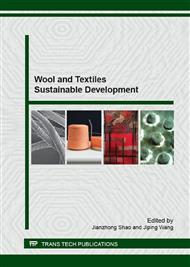p.149
p.157
p.173
p.179
p.186
p.191
p.197
p.202
p.210
A Novel Softening Finishing of Cotton Fabrics by Silicone Softener/D5 Dispersion System
Abstract:
Due to the cumbersome emulsification process and water pollution, the traditional softening finishing by silicone softener in aqueous bath can not fulfill the acquirements of energy saving and emission reduction during the production of cotton fabrics. For this reason, a novel water-free system containing silicone softener and decamethyl cyclopentasiloxane (D5) is introduced to the softening finishing. Compared to the traditional softening finishing in aqueous bath, the novel softening finishing system can obtain almost the same softening finishing effect and the adsorption rate of silicone softener is about 75%. In the meanwhile, the finishing can be processed at a lower temperature. Simultaneously the water pollution can be prevented due to the fact that D5 can be recycled after finishing. The finishing conditions including mangle expression, bath ratio of D5, finishing temperature and finishing time were optimized by evaluating the curve area value and softness score of PhabrOmeter3 fabric evaluation system. The result indicated that simple preparation and eco-friendly finishing could be realized by applying the novel D5 softening finishing system. From the investigation, the novel system with silicone softner/D5 dispersion can be a promising candidate for the softening finishing in future, as it is environmental friendly.
Info:
Periodical:
Pages:
186-190
Citation:
Online since:
November 2015
Authors:
Price:
Сopyright:
© 2016 Trans Tech Publications Ltd. All Rights Reserved
Share:
Citation:


